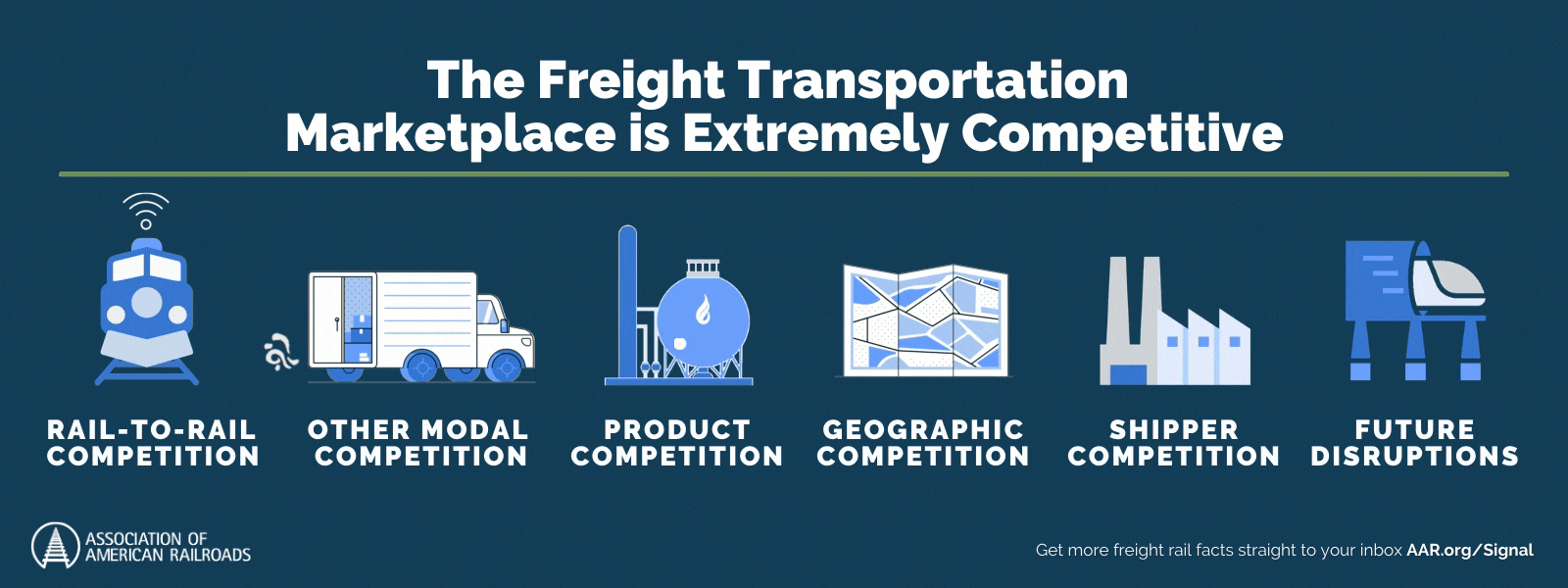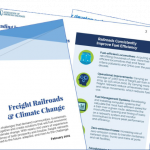Railroads Face Fierce Competition
Spurred in large part by e-commerce and global population growth, the U.S. Department of Transportation estimates demand for freight will grow 30% by 2040.
Railroads are the best way to meet much of this increased demand. They are the most environmentally friendly way to move freight over land; are extremely safe; and efficiently and cost effectively haul freight across a vast 140,000-mile national network.
However, railroads are not guaranteed a slice of the freight transportation pie. Instead, they must earn it by offering the price and service that their customers want while taking on multiple types of competition. This includes from other railroads, other modes of transportation, product competition and geographic competition. Rail customer needs are changing as the transportation market quickly evolves. Railroads are adapting to meet these needs by privately investing in infrastructure, equipment and technology to provide safe, cost-effective and reliable service.
To be successful in such a competitive marketplace, railroads must have policies that allow them to continually invest back into their network. A healthy and competitive freight rail system is critical to our transportation network and our national economy.
Freight railroads serve shippers from almost every industrial, wholesale, retail and resource-based sector of the economy.
For some shippers, transportation costs can determine the transportation mode they select. These dynamics mean railroads must provide reliable and affordable service. The Surface Transportation Board (STB) is the economic regulator of freight railroads. The STB helps ensure railroads earn adequate revenues and that shippers have access to reasonably priced and efficient rail service. The STB can set maximum reasonable rates or take other actions if a railroad has acted improperly. Most rail customers — including those served by only one railroad — do not need STB regulatory protection because market forces ensure competitive rates and service.
Rail shippers are not “captive” to railroads.
The simple truth is that access to only one railroad does not mean there is a lack of transportation options for that shipper. Some shippers mischaracterize themselves as “captive” if they only have access to one railroad. This message is misleading for a couple reasons. First, most rail customers have always been served by only one railroad, as most shippers cannot economically support two railroads, just like most cities cannot support two MLB teams. Second, many shippers have other modal options, like truck or water carrier, to move their products. The reason that most rail traffic is not subject to STB regulation is because there are competitive forces in the marketplace that make regulatory oversight unnecessary. Therefore, a shipper is not “captive” just because two railroads do not come to its front door.
Rail mergers did not create “captive” shippers.
The economic regulator of the industry — the STB — must authorize rail mergers. For over 50 years, if a proposed merger would have reduced rail-to-rail competition, the regulator has either rejected it or imposed mitigating conditions. In fact, mitigation conditions, like trackage rights, were placed on every major merger since the Staggers Act, to ensure shippers that had multiple railroads serving them prior to the merger still had multiple-railroad service following the merger. Most importantly, no merger has allowed a shipper to go from two railroads to one.
In addition, the last major merger was more than 20 years ago. Mergers have done nothing to reduce regulators’ substantial authority to protect shippers against unreasonable railroad pricing or practices, much less create captivity. Instead, mergers created the efficient rail network we have today. They extended the benefits of single-line service to more shippers, for more commodities, over longer distances, while opening new markets for shippers in the process. Railroads passed many of these productivity gains to their customers in the form of lower rates. Average rail rates today are 43% lower than in 1981, meaning the average rail shipper can move significantly more freight for about the same price it paid more almost 40 years ago.

Rapid technological innovations like autonomous trucks and even hyperloop will only increase the competitive landscape. Here are just a few examples of the many competitive restraints railroads currently face:
Rail-to-rail competition
Railroads are private companies that compete against each other for business. Rail customers often have connections to competing railroads, either directly or in conjunction with a short-haul truck movement. Some rail customers can also build (or credibly threaten to build) a new rail line to a competing railroad.
Other modal competition
Most rail customers can also ship via trucks, barges and/or pipelines. Trucks are freight rail’s largest competitor. However, trucks use infrastructure (e.g., public highways) subsidized by the federal government, while railroads fully fund their infrastructure. This means the costs trucks offer shippers are artificially deflated.
Many experts agree that trucks — which are not subject to the same type of regulatory scrutiny as railroads — will deploy a combination of autonomous, electric and platooning vehicles in the near future. These technological advancements could increase delivery times, improve on-time performance and significantly lower trucks’ labor and fuel costs — making trucks even fiercer competition for railroads.
Product competition
Product competition refers to the widespread ability of a firm to substitute one product for another in its production process. For example, a utility can generate electricity from natural gas (which railroads do not generally carry) instead of coal (which railroads do carry). Similarly, a fertilizer manufacturer may substitute soda ash moved by rail, with caustic soda transported by truck. Therefore, product options can also constrain transportation rates.
Geographic competition
A rail customer can often get the same product from — or ship the same product to — a different geographic area. For example, taconite is a low-grade iron ore, that when combined with clay, creates pellets that can be transported to steel manufacturers and melted into steel. This clay is available from Wyoming mines served by one railroad and from Minnesota mines served by another. Iron ore producers can pit one railroad against the other for clay deliveries. This is another type of real-world competition, called geographic competition, that also constrains rail rates.
Shipper generated competition
Shippers can also generate competition between railroads before they build a manufacturing plant. They do this by negotiating favorable contracts when evaluating potential plant locations. Over the long term, shippers can locate or relocate plants on the lines of different railroads. Shippers often make the business decision to locate their facilities at sites with access to only one railroad. This means other factors, aside from having multiple rail service options, can drive the decision to locate a shipper’s facility.
Future disruptions
Technological, regulatory or structural changes over time will give shippers leverage over railroads. For example, fracking made natural gas much more abundant and less expensive. In turn, natural gas delivered via pipeline become the preferred fuel source for electricity generation, instead of coal delivered by trains. This marketplace disruption constrains the rates railroads can charge for delivering coal to utilities.
Additional technological changes that disrupt the transportation market and increase competition are sure to come in the years ahead, including transformative technologies like hyperloop. Although we cannot predict the future, we do know that new technologies have the potential to not only disrupt the transportation market, but also enhance competition.



